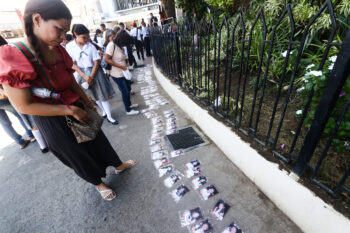DAVAO CITY (MindaNews/04 September) — Are dengue fever cases and resulting deaths much higher than are currently being reported? Why is nobody sounding the alarm bell on the current outbreak of dengue fever now sweeping the country?
Each year, tens of thousands of cases of dengue go unreported and death rates, mostly among children, are far higher than the national statistical data collected and reported by the Department of Health (DOH).
Do we really know the true cost to the nation in terms of young lives lost annually from this insidious mosquito borne killer virus? Could we be better prepared to save more lives with better information, clearer policies, improved medical response, and more focussed community-based interventions?
Globally, 2.5 billion people live in areas where the dengue virus is present. The emergence of dengue hemorrhagic fever (DHF), which first starts with flu-like symptoms, was first reported in epidemic outbreaks in the Philippines during the 1950s. Since then, some 36 countries around the world have reported sporadic epidemic level outbreaks of dengue, and the Philippines is one of the countries most affected by this mosquito transmitted virus, which continues to be a leading cause of death among children.
There are four known virus types of dengue, carried by the white spotted Aedes aegypti mosquito, all found in the Philippines. There are no known medical cures for the dengue virus, although researchers are currently working on promising new vaccines. Community-based prevention and control practices – eliminating mosquito breeding places – remain the best way of preventing the spread of dengue.
Preventable
Yet community awareness, government response, and medical community preparedness are ill-prepared to deal with sudden outbreaks of dengue, such as what we are seeing today. As a result, alarming numbers of children are dying each year from this virus. The majority of these deaths could easily be prevented, with better and more focused quick response measures adopted by both the government and the private sector.
What is needed is better and faster case reporting and public information dissemination procedures, improved coordination and networking between blood banks to ensure 24/7 blood platelet accessibility in all major urban centers and surrounding communities that depend on that support, and increased community-based awareness programs coupled with practical proactive mosquito breeding ground eradication and control measures. More than ever, we need close public and private sector cooperation to address these challenges, otherwise nothing will change!
We are told that early detection and treatment of dengue fever can result in a 99% survival rate, a statistic frequently broadcast to the public by health sector officials and practitioners. What is not widely reported to the public is that if undetected or untreated, cases of dengue fever frequently result in a death rate of one in five (1 in 5) persons affected. It is not a far stretch of the imagination to expect that the vast majority of dengue fever cases, and resulting fatalities, in the Philippines go unreported each year. This is particularly true in small towns, rural barangays and more remote upland communities with limited access to medical facilities and LGUs understaffed to monitor medical reporting.
We are currently witnessing a major outbreak of dengue in the country, yet no one seems to be reporting on the subject. The U.S. Center for Disease Control and Prevention (CDC), as of the last week of August, 2012, shows 41 locations throughout the Philippines on their worldwide Dengue Map where dengue cases are currently being reported (12 location in Mindanao, 17 in the Visayas, and 12 in Luzon). The latest reporting published on the website of the Department of Health as of July 14, 2012 shows 51,597 active cases of dengue reported in the Philippines since January this year.
Inconsistencies
The DOH published data from January through June shows a total of 48,731 dengue cases reported in 2012, as compared to 37,436 such cases for the same six-month period in 2011, an increase in the first half of this year of over 30.2%. But in 2011, the number of dengue cases increased dramatically during the months of July and August, which in all likelihood it has this year as well, particularly in the aftermath of the recent massive flooding problems in Luzon and the Visayas and persistent drought conditions in many parts of Mindanao, that create ideal environments for mosquitoes to reproduce. We will have to wait for several more weeks for the complete reporting for this current two-month period to know the answer. As of the latest DOH mid-July published data, dengue cases were being reported from virtually every region within the country.
A review of past dengue case and fatality reporting in the country shows inconsistencies. National Statistics Office published records show 25,000 or fewer cases of dengue were reported in the country each year during the period 2001-2008.
For 2007 the number of dengue cases reported, according to NSO records, was 11,915, yet published DOH and world health records for the same year show over 40,000 dengue cases reported in the Philippines.
For 2011, DOH records show that there were about 119,000 cases of dengue reported. Yet fatality statistics related to dengue for last year were only reported to be 293, which is about one quarter of one percent of all cases reported.
Looking at it from another angle, this would suggest that the Philippines is doing a four-times-better job in reducing dengue-related deaths than the worldwide average of one percent mortality, given an artificial environment where there is early detection and treatment in every single reported case!
The unfortunate truth is we are no where near optimal mortality rates associated with dengue, particularly when we consider the number of cases which are not detected, treated or reported. Accurate and timely data would undoubtedly show the number of people contracting this virus annually to be several times higher than that currently being reported.
Given that up to 20% of these non detected, treated or reported cases usually results in death, we can assume that a far greater number of people, particularly children, are dying weekly, monthly and annually from this virus than our current data suggests.
Is it not believable that the actual number of dengue cases might be closer to a half million annually with a mortality rate closer to 5-6% or higher?
To be sure, the medical community and government would have a difficult time of confronting such numbers. But is it not time, for the sake of public awareness and response, for those concerned to take affirmative action to improve the quality and timeliness of our reporting and information sharing systems with respect to this deadly virus?
Blood platelet supply
Another unfortunate reality is that a significant number of the deaths resulting from dengue exposure are preventable and due to the lack of timely access to life-saving blood platelet transfusions. This is in large part due to a failure of our blood banks, particularly those located in key urban centers, to be able to assure 24/7 access within their coverage areas and surrounding communities to critically needed blood-type supply.
Hospitals in smaller towns and rural areas often depend on these urban-based blood banks to meet their time-sensitive blood supply needs. This applies to many other life-saving conditions than just dengue. Maintaining adequate blood supply in every community to cope with the medical needs of the hour, particularly those resulting from viral outbreaks or epidemics, is a shared community responsibility.
However, the blood banks and medical community can do a far better job than they are currently doing to reduce blood supply shortages that continually occur throughout the country.
We need to change the practice of placing the bulk of the burden for sourcing blood on the backs of family members and friends of sick patients, those often least prepared to handle the situation. Instead, there needs to be more proactive response from the medical community, with policies and plans in place, to eliminate these blood supply shortages whenever and wherever possible.
In this age of modern communication and technology, blood banks can do a much better job of communicating and networking with each other to avert blood-type shortages from occurring in key urban locations within the country. =
The science of safely and securely transporting blood on a routine schedule from one urban location to another to avert blood-type shortages is not rocket science. Public officials and health sector private providers need to sit together to devise a plan and install a system to hourly monitor blood-type availability in key urban centers throughout the country. They need next to develop a more timely response mechanism to improve blood bank supply.
That might mean improving community awareness and responsiveness to bloodletting campaigns. It might also entail sitting with airline executives to devise a plan for efficiently transporting blood supplies on first hour and final hour commercial flights between key urban hubs.
Finally, they need to decide who is in charge of managing this effort.
To be sure, the number of dengue fatalities could be significantly reduced with better and more timely access to blood platelet supply.
In any case, is it not time to for those in the health community to sit down and start talking with each other on finding practical solutions to this problem?
Finally, local communities and LGUs need to adopt more focussed dengue interventions to improve community awareness, preparedness and response to dengue outbreaks.
This of course requires better access to information, improved community outreach and community-led efforts to implement more timely and effective mosquito prevention and control techniques. Local communities are the front line in this battle against this killer virus.
At the national and local levels, it is time for policy-level discussions to once again be held on the merits of aerial and ground spraying, fogging, and other less controversial best practice mosquito eradication solutions.
Sri Lanka, for example, employs hundreds of private sector vendors on bicycles with backpack fogging machines who routinely spray environmentally friendly mosquito and larva killing solutions in the yards and common access areas of community households. The cost is about P150 per treatment per household.
This community-led effort has resulted in a significant reduction in the incidence of dengue outbreaks in Sri Lanka. It has also contributed to employment generation and income growth within the communities.
Is it not time for us in the Philippines to put our heads together and find community-based solutions to better control this perennial virus that has and continues to claim the lives of so many of our young people?
(MindaViews is the opinion section of MindaNews. Mark Van Steenwyk is a permanent resident in the Philippines, now living in Davao City. Since he started his career in 1971 as a young peace corps volunteer assigned to the Bureau of Animal Industry in Nueva Ecija, he has worked in the field of socio-economic development in over 20 countries in the Asia region. He has called the Philippines “home” for most of the past four decades and has contracted dengue fever twice, the first time in Manila in 1975, and in Davao last month, where he nearly lost his life. He contributes this piece in the interest of improving public awareness and dialogue on safeguards and other measures to help reduce the incidence of child mortality in the Philippines due to dengue fever.)







